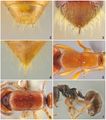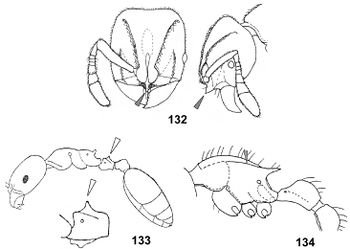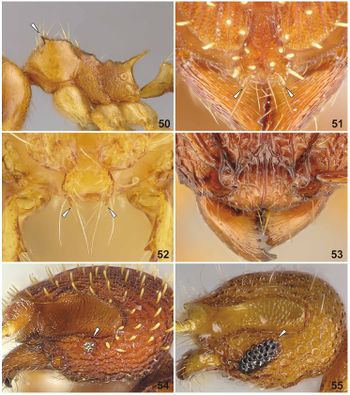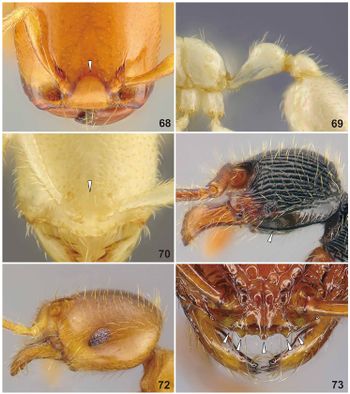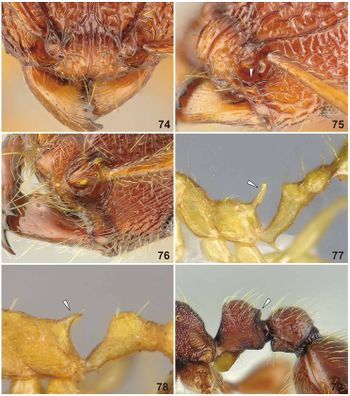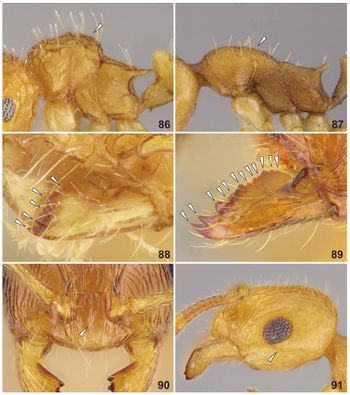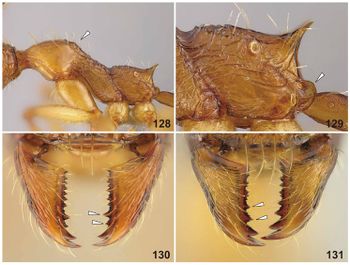Key to Vietnamese Myrmicinae Genera
This worker key is based on: Eguchi K., Bui T.V. and Yamane S. 2011. Generic synopsis of the Formicidae of Vietnam. Part 1 – Myrmicinae and Pseudomyrmecinae. Zootaxa 2878: 1-61.
- Eguchi et al. 2011
You may also be interested in
Ants of Vietnam
The following key to genera includes the following genera which have been known from Thailand, southern China and/or Taiwan, but not yet been found from Vietnam: Eurhopalothrix; Formosimyrma; Leptothorax; Metapone; Perissomyrmex; Rotastruma; Rostromyrmex; Stenamma.
1
- Postpetiole attached to the dorsum of abdominal segment IV (= gastral segment I) (Fig. 37); petiole flattened dorsoventrally . . . . . Crematogaster
- Postpetiole attached to the anterior face or ventrum of abdominal segment IV (Fig. 38), or, in Anillomyrma, postpetiole attached to the top of anterior face but not the dorsum of abdominal segment IV (Fig. 39); petiole variable in shape, but never flattened dorsoventrally . . . . . 2
2
return to couplet #1
- Antennal scrobe running below eye (Fig. 40) . . . . . 3
- Antennal scrobe absent or running above eye (Fig. 41); in some genera both eye and antennal scrobe absent . . . . . 4
3
return to couplet #2
- Antenna 11-segmented; first gastral tergite greatly expanded, comprising the whole of the dorsum of gaster in dorsal view . . . . . Cataulacus
- Antenna 7-segmented; first gastral tergite never comprising the whole of the dorsum of gaster in dorsal view . . . . . Eurhopalothrix (not yet found from Vietnam)
4
return to couplet #2
- Antenna with 4–6 segments . . . . . 5
- Antenna with 7–12 segments . . . . . 7
5
return to couplet #4
- Mandible with a series of teeth on its masticatory margin (Fig. 42) . . . . . Pyramica (= Smithistruma) (in part - also #6)
- Mandible without a series of teeth on its inner margin except apical teeth (Fig. 43) . . . . . 6
6
return to couplet #5
- Mandibular bases located closely (Fig. 44); labrum not forming exaggerated distal processes . . . . . Pyramica (= Smithistruma)
- Mandibular bases broadly separated (Fig. 45); labrum forming exaggerated distal processes (Fig. 46) . . . . . Pyramica (= Smithistruma) (argiola- and murphyi-groups: not yet found from Vietnam) (in part - also #5)
7
return to couplet #4
- Antenna with 7 segments . . . . . Myrmicaria
- Antenna with 8–12 segments . . . . . 8
8
return to couplet #7
- Median portion of clypeus with a thin longitudinal wall which is produced well anteriad in full-face view (Fig. 132) . . . . . 9
- Median portion of clypeus round, angulately produced, truncate, bicarinate or with a bilobed projection, but never with a thin longitudinal wall . . . . . 10
9
return to couplet #8
- Antenna with 8 segments . . . . . Formosimyrma (not yet found from Vietnam)
- Antenna with 9 segments . . . . . Rostromyrmex (not yet found from Vietnam)
10
return to couplet #8
- Dorsum of mesonotum flattened and forming flanges laterally and posteriorly (Fig. 47) . . . . . Meranoplus
- Dorsum of mesonotum sometimes flattened and margined laterally but never forming flanges laterally and posteriorly (Fig. 28) . . . . . 11
11
return to couplet #10
- Promesonotum with 8 digitiform tubercles (4 pairs) (Fig. 48) . . . . . Proatta
- Promesonotum usually without digitiform tubercles (Fig. 49), but sometimes with a spine or denticle on each humerus (Fig. 50), or with a large prominence on each humerus and a tubercle in front of metanotal groove . . . . . 12
12
return to couplet #11
- Median portion of clypeus forming a bilobed projection near the highest point (Figs. 51, 52) . . . . . 13
- Median portion of clypeus not armed with a bilobed projection near the highest point (Figs. 53) . . . . . 14
13
return to couplet #12
- Antenna 12-segmented; eye small and round (Fig. 54) . . . . . Calyptomyrmex
- Antenna 10-segmented; eye large and elongate (Fig. 55) . . . . . Mayriella
14
return to couplet #12
- Antenna terminating in a conspicuous 2-segmented club (Fig. 56) . . . . . 15
- Antenna terminating in a 3-segmented (Fig. 57) or 4-segmented club, or without a conspicuous club (Fig. 58) . . . . . 19
15
return to couplet #14
- Frontal lobes touching or separated only by a narrow longitudinal impression (Fig. 59); postpetiole broadly attached to gaster . . . . . Rhopalomastix
- Frontal lobes distinctly separated by median portion of clypeus (Fig. 60); postpetiole narrowly attached to gaster . . . . . 16
16
return to couplet #15
- Anterior margin of clypeus with an unpaired long seta at the midpoint (Fig. 61). (because the median seta often absent in the major worker of polymorphic Solenopsis species, the minor worker may be needed for identification) . . . . . 17
- Anterior margin of clypeus without an unpaired median seta, instead either with a pair of long setae straddling the midpoint (Fig. 62), or with an unbroken row of setae . . . . . 18
17
return to couplet #16
- Antenna 9- or 10- segmented; masticatory margin with apical tooth followed by 2 distinct teeth and then one or more small or inconspicuous denticles (Fig. 63) . . . . . Solenopsis
- Antenna 11 segmented; masticatory margin with 5 distinct teeth (Fig. 64) . . . . . Parvimyrma
18
return to couplet #16
- Minor worker with median part of clypeus margined laterally with carinae (Fig. 65) . . . . . Oligomyrmex
- Minor worker with median part of clypeus never margined laterally with carinae (Fig. 66) . . . . . Carebara
19
return to couplet #14
- Eyes completely absent . . . . . 20
- Eyes present, usually well developed but sometimes consisting of only one or a few ommatidia . . . . . 21
20
return to couplet #19
- Subpetiolar process well developed (Fig. 67); antenna 11-segmented; frontal lobes widely separated (Fig. 68) . . . . . Liomyrmex
- Subpetiolar process absent (Fig. 69); antenna 10-segmented; frontal lobes very closely approximated (Fig. 70) . . . . . Anillomyrma
21
return to couplet #19
- Antenna with 9 segments . . . . . Perissomyrmex (not yet found from Vietnam)
- Antenna with 11–12 segments . . . . . 22
22
return to couplet #21
- Antenna with 11 segments . . . . . 23
- Antenna with 12 segments . . . . . 36
23
return to couplet #22
- Antennal scrobe very deep and capable of largely concealing scapes . . . . . Metapone (not yet found from Vietnam)
- Antennal scrobe absent, or present but incapable of concealing scapes (Fig. 41) . . . . . 24
24
return to couplet #23
- Head below eye with a longitudinal ridge that is distinguishable from the background sculpture (Fig. 71) . . . . . Myrmecina (in part - also #37)
- Head below eye without a longitudinal ridge that is distinguishable from the background sculpture (Fig. 72) . . . . . 25
25
return to couplet #24
- Antennal socket fully exposed; anterior margin of clypeus with three or more denticles (Fig. 73) . . . . . Pristomyrmex (in part - also #33)
- Antennal socket partly or completely concealed by frontal lobe; anterior margin of clypeus at most with two denticles or angles (Fig. 74) . . . . . 26
26
return to couplet #25
- Lateral portion of clypeus in front of antennal socket raised into a sharp-edged ridge (Fig. 75); sting with a spatulate to triangular, lamellate appendage that projects from the dorsum of the shaft close to its apex . . . . . Tetramorium (in part - also #43)
- Lateral portion of clypeus in front of antennal socket not raised into a sharp-edged ridge (Fig. 76); sting simple, without a lamellar appendage that projects from the dorsum of the shaft . . . . . 27
27
return to couplet #26
- Propodeal spine recurved at least weakly (Fig. 77) . . . . . Recurvidris
- Propodeal spine, if present, straight or down-curved (Fig. 78) . . . . . 28
28
return to couplet #27
- Posterodorsal margin of petiole produced posterodorsad as a rim which is distinctly (or at least a little) higher than the dorsal outline of helcium of petiole when waist segments stretched posteriad (Fig. 79) . . . . . Vollenhovia (in part - also #46)
- Posterodorsal margin of petiole not forming a rim mentioned above (Fig. 80) . . . . . 29
29
return to couplet #28
- Dorsa of head and mesosoma without distinct standing hairs; postpetiole in dorsal view at least twice as broad as petiolar node (Fig. 81) . . . . . Cardiocondyla (part: species with 11-segmented antenna have not yet been found from Vietnam) (in part - also #51)
- Dorsa of head and mesosoma with standing hairs; postpetiole in dorsal view less than twice as broad as petiolar node (Fig. 82) . . . . . 30
30
return to couplet #29
- Petiole in lateral view without a distinct anterior peduncle, but with triangular node the dorsolateral corners of which form acute angles or denticles; subpetiolar process large (Fig. 133) . . . . . Gauromyrmex
- Petiole in lateral view pedunculate, with a round node; subpetiolar process absent or present as a tiny denticle or angle . . . . . 31
31
return to couplet #30
- Anterior margin of clypeus with a single long seta at the midpoint (Fig. 83) . . . . . Monomorium (in part - also #52)
- Anterior margin of clypeus without a single median seta, instead either with a pair of long setae straddling the midpoint, or with an unbroken row of setae (Fig. 84) . . . . . 32
32
return to couplet #31
- Promesonotum in lateral view distinctly raised from the dorsum of propodeum (Figs. 85, 86) . . . . . 33
- Promesonotum in lateral view not or only weakly raised from the dorsum of propodeum (Fig. 87) . . . . . 34
33
return to couplet #32
- Masticatory margin of mandible with 5 conspicuous teeth (Fig. 88) . . . . . Pristomyrmex (part: P. profundus) (in part - also #25)
- Masticatory margin of mandible with apical and one preapical tooth, followed by an enlarged denticle; these then followed by a series of small denticles (Fig. 89) . . . . . Lophomyrmex
34
return to couplet #32
- Masticatory margin of mandible with 7 or more teeth; anterior clypeal margin forming an obtuse median angle . . . . . Lasiomyrma (part: species with 11-segmented antennae have not yet been found from Vietnam) (in part - also #56)
- Masticatory margin of mandible with 5 or 6 teeth; anterior clypeal margin not forming an obtuse median angle . . . . . 35
35
return to couplet #34
- Median clypeal carina absent; mouthparts with stipes of the maxilla with a transverse crest present at about its midlength . . . . . Leptothorax (not yet found from Vietnam)
- Median clypeal carina present (Fig. 90); mouthparts with stipes of the maxilla without a transverse crest at about its midlength . . . . . Temnothorax (part: species with 11-segmented antennae have not yet been found from Vietnam) (in part - also #53)
36
return to couplet #22
- Head in lateral view below eye with a longitudinal ridge (Fig. 71) or groove (Fig. 91) that is distinguishable from the background sculpture . . . . . 37
- Head in lateral view below eye without a longitudinal ridge or groove that is distinguishable from the background sculpture (Fig. 92) . . . . . 38
37
return to couplet #36
- Longitudinal ridge on the ventrolateral part of head never touching the eye; petiole short and sessile, lacking a node (Fig. 93) . . . . . Myrmecina (in part - also #24)
- Longitudinal groove on the lateral part of head touching the ventral margin of eye; petiole elongate and weakly pedunculate, with a low node (Fig. 94) . . . . . Vombisidris
38
return to couplet #36
- Petiole elongate and cylindrical (Fig. 95); posterolateral corner of head with a small acute angle or denticle exterior to preoccipital carina . . . . . Dilobocondyla
- Petiole variable in shape (Fig. 96, 97); posterolateral corner of head usually round, or sometimes forming a vertexal lobe, but lacking a small acute angle or denticle . . . . . 39
39
return to couplet #38
- Tergo-sternal suture of gastral segment I in anterior view describing a parabola on each side of the articulation with postpetiole (Fig. 98) . . . . . Acanthomyrmex
- Tergo-sternal suture of gastral segment I in anterior view transverse or bending downwards on each side of the articulation with postpetiole (Fig. 99) . . . . . 40
40
return to couplet #39
- Lateral portion of clypeus in front of antennal socket raised into a conspicuous vertical ridge or wall (Figs. 75, 100) . . . . . 41
- Lateral portion of clypeus in front of antennal socket not raised into a ridge or wall (Fig. 101) . . . . . 44
41
return to couplet #40
- Promesnotum in lateral view strongly raised as a dome (Fig. 102: pm); each humerus of promesonotum forming a high and blunt mound (Fig. 102: hp) . . . . . Dacatria
- Promesnotum in lateral view not or slightly higher than anterodorsal border of propodeum; each humerus of promesonotum not forming a high and blunt mound (Fig. 103) . . . . . 42
42
return to couplet #41
- Head in full-face view roughly heart-shaped, with posterolateral corners relatively strongly produced (Fig. 104); propodeal lobe reduced to a low carina . . . . . Rhoptromyrmex (in part - also #48)
- Head in full-face view roughly oval or subrectangular, with posterolateral corners not or weakly produced (Fig. 105); propodeal lobe well developed usually as a triangular lamella or spinose projection but sometimes as a subrectangular or round lamella . . . . . 43
43
return to couplet #42
- Tibial spurs of middle and hind legs pectinate (Fig. 106); sting simple; palp formula (number of segments in maxillary palp and labial palp) 6,4 . . . . . Myrmica (part: species in which lateral portion of clypeus is raised as ridge have not yet been found from Vietnam) (in part - also #57)
- Tibial spurs of middle and hind legs simple or absent (Fig. 107); apex of sting with a small lamellate appendage; palp formula 4,3 or less . . . . . Tetramorium (in part - also #26)
44
return to couplet #40
- Middle part of masticatory margin without teeth or denticles (Fig. 108) . . . . . Pheidole (major workers) (in part - also #54) (in part - also #59)
- Middle part of masticatory margin with teeth or denticles (Fig. 109) . . . . . 45
45
return to couplet #44
- Frontal carina distinct, in full-face view extending close to posterolateral corner of head; antennal scrobe moderately to strongly developed (Fig. 110) . . . . . Lordomyrma (in part - also #56)
- Frontal carina and antennal scrobe absent (Fig. 111), or present but weak . . . . . 46
46
return to couplet #45
- Posterodorsal margin of petiole produced posterodorsad as a rim which is distinctly (or at least a little) higher than the dorsal outline of helcium of petiole when waist segments stretched posteriad (Fig. 79) . . . . . Vollenhovia (in part - also #28)
- Posterodorsal margin of petiole not forming a rim mentioned above (Fig. 112) . . . . . 47
47
return to couplet #46
- Mesosoma marginate dorsolaterally, especially on mesonotum and propodeum (Fig. 134) . . . . . Rotastruma (not yet found from Vietnam)
- Mesosoma not marginate dorsolaterally . . . . . 48
48
return to couplet #47
- Head in full-face view roughly heart-shaped, with posterolateral corners relatively strongly produced (Fig. 104); apical part of sting dorsally with a triangular to pennant-shaped appendix projecting upwards from the shaft (visible only when the sting is extended) . . . . . Rhoptromyrmex (in part - also #42)
- Head in full-face view roughly oval or rounded-rectangular (Figs. 113, 114), rarely with a long neck; posterolateral corners not or weakly produced; apical part of sting without a dorsal appendix . . . . . 49
49
return to couplet #48
- Antenna terminating in a 3-segmented club . . . . . 50
- Antenna terminating in a 4-segmented club, or without a conspicuous club . . . . . 57
50
return to couplet #49
- Anteromedian part of vertex with a conspicuous depression (Fig. 115) . . . . . Kartidris
- Anteromedian part of vertex without a conspicuous depression (Fig. 116) . . . . . 51
51
return to couplet #50
- Both median and lateral part of clypeus well produced anteriad and forming a shelf which largely overhangs mandibles (Fig. 117); dorsum of head and mesosoma without standing hairs . . . . . Cardiocondyla (in part - also #29)
- Median part of clypeus more or less produced anteriad, but not forming a shelf which largely overhangs mandibles (Fig. 118); dorsum of head and mesosoma usually (but not always) with standing hairs . . . . . 52
52
return to couplet #51
- Anterior margin of clypeus with a single long seta at the midpoint (Fig. 83); propodeal spines absent . . . . . Monomorium (in part - also #31)
- Anterior margin of clypeus without a single median seta, insteard either with a pair of long setae straddling the midpoint (Fig. 119), or with an unbroken row of setae; propodeal spines usually developed, but rarely reduced to tiny denticles . . . . . 53
53
return to couplet #52
- Masticatory margin of mandible with 5–6 teeth (Fig. 120) . . . . . Temnothorax (in part - also #35)
- Masticatory margin of mandible with 7 or more teeth/denticles (Fig. 121) . . . . . 54
54
return to couplet #53
- Promesonotum distinctly higher than anterior border of propodeal dorsum (Fig. 122) . . . . . Pheidole (in part - also #44) (in part - also #59)
- Promesonotum not or only a little higher than anterior border of propodeal dorsum (Fig. 123) . . . . . 55
55
return to couplet #54
- Anterior margin of clypeus round with a slight emargination medially; petiolar node in lateral view cuboidal, long (Fig. 124); postpetiole in lateral view compressed dorsoventrally, longer than high . . . . . Paratopula
- Anterior clypeal margin forming an obtuse angle; petiolar node in lateral view round or blunt-triangular (Fig. 125); postpetiole in lateral view not compressed dorsoventrally, higher than long . . . . . 56
56
return to couplet #55
- Petiole in lateral view blunt-triangular and thin . . . . . Lasiomyrma (in part - also #34)
- Petiole in lateral view round and thick . . . . . Lordomyrma (in part - also #45)
57
return to couplet #49
- Promesonotum slightly raised (Fig. 126); propodeal lobe well developed as a triangular or sharp lamella (Fig. 127) . . . . . Myrmica (in part - also #43)
- Promesonotum strongly raised as a dome (Fig. 128); propodeal lobe round or subtriangular with blunt angles (Fig. 129). . . . . . 58
58
return to couplet #57
- Posteromedian portion of clypeus, where it is inserted between the frontal lobes, narrower than one of the frontal lobes; median portion of clypeus defined laterally by weak clypeal carinae . . . . . Stenamma (not yet found from Vietnam)
- Posteromedian portion of clypeus, where it is inserted between the frontal lobes, broader than one of the frontal lobes; median portion of clypeus not defined laterally by clypeal carinae . . . . . 59
59
return to couplet #58
- Masticatory margin of mandible with 1 or 2 small denticles between the preapical tooth and 3rd large tooth (Fig. 130); palp formula 3,2 or less . . . . . Pheidole (in part - also #44) (in part - also #55)
- Masticatory margin of mandible without small teeth/denticles between the preapical tooth and 3rd large tooth (Fig. 131); palp formula 5,3 or 4,3 . . . . . Aphaenogaster
